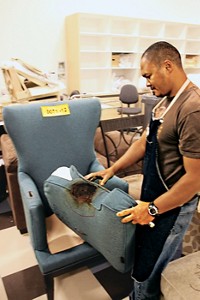Advertisement
Grab your lab coat. Let's get started
Welcome!
Welcome!
Create an account below to get 6 C&EN articles per month, receive newsletters and more - all free.
It seems this is your first time logging in online. Please enter the following information to continue.
As an ACS member you automatically get access to this site. All we need is few more details to create your reading experience.
Not you? Sign in with a different account.
Not you? Sign in with a different account.
ERROR 1
ERROR 1
ERROR 2
ERROR 2
ERROR 2
ERROR 2
ERROR 2
Password and Confirm password must match.
If you have an ACS member number, please enter it here so we can link this account to your membership. (optional)
ERROR 2
ACS values your privacy. By submitting your information, you are gaining access to C&EN and subscribing to our weekly newsletter. We use the information you provide to make your reading experience better, and we will never sell your data to third party members.
Policy
Effort To Create National Furniture Flammability Standard Grinds On
by Cheryl Hogue
October 29, 2012
| A version of this story appeared in
Volume 90, Issue 44
While California moves quickly to revise its flammability limits for furniture, the Consumer Product Safety Commission continues work begun nearly two decades ago to establish the first national standard on the flammability of upholstered furniture. CPSC proposed a standard four years ago. But the federal agency still has many technical and legal details to address. It is unclear when a nationwide, legally enforceable standard to prevent ignition of upholstered furniture might be realized.
COVER STORY
Effort To Create National Furniture Flammability Standard Grinds On
CPSC’s effort started in 1994. In response to a petition by the National Association of State Fire Marshals, the commission that year laid out plans to regulate the risks from upholstered-furniture fires ignited by small open flames such as candles and cigarette lighters. Nine years later, in 2003, CPSC expanded these plans to cover ignition by smoldering cigarettes too.
In 2008, the commission proposed a standard under the Flammable Fabrics Act (FFA) that is intended to reduce the chance of upholstered furniture igniting from contact with a smoldering object such as a cigarette. CPSC focused on risks from smoldering items because, the proposal says, “the majority of deaths and injuries resulting from fires involving upholstered furniture were started by smoldering ignition sources,” almost always cigarettes. A significantly smaller number of fires involving upholstered furniture are started by small open flames, according to CPSC.
The proposal would establish performance requirements, rather than specify the use of flame-retardant chemicals or particular materials or designs. Furniture manufacturers could meet the standard in one of two ways: They could build furniture covered with fabrics that pass a CPSC-developed test using a smoldering cigarette. Or they could incorporate fire barriers between the outer fabric and flammable padding materials. Under the second option, furniture would have to pass both an open-flame and a smolder-ignition test.
The American Home Furnishings Alliance, which represents furniture makers, welcomed the 2008 proposal. “Consistently over time, CPSC statistics show that 90% of upholstered-furniture fires result from smolder ignition,” Andy Counts, chief executive officer of the alliance, told a Senate hearing in July. “An approach that addresses only smolder ignition is not perfect,” according to Counts. “After finalization of a standard that addresses smolder ignition, CPSC resources can then be concentrated on determining if potential solutions to small, open-flame risk exist and are justified.”
In contrast, the North American Flame Retardant Alliance—an industry group consisting of Albemarle, Chemtura, and ICL Industrial Products—says the draft standard is inadequate. “It fails to recognize the risk of ignition from small open flames such as candles or matches,” says Bryan Goodman, spokesman for the alliance of makers of flame-retardant chemicals.
The Consumer Federation of America, in contrast, backs CPSC’s plan to rely on a smolder-ignition standard. This, the consumer advocacy group says, “will not only result in superior fire safety for consumers, but will also discourage the use of halogenated fire-retardant chemicals in furniture filling materials, which have been associated with serious health impacts to humans, wildlife, and the environment.”
Since releasing the proposal in 2008, CPSC has focused on finalizing this regulation. But the agency still faces several challenges.
For one, the agency must develop flammability testing protocols that reflect the diversity of upholstered furniture. “Unlike other products, such as mattresses, furniture comes in a multitude of sizes and shapes, making representative and repeatable testing mechanisms a substantial undertaking,” says Inez M. Tenenbaum, who chairs CPSC. She says CPSC staff is making progress on this front. Completing the standard is a major goal for Tenenbaum, who was appointed to the commission in 2009.
“Currently, CPSC staff is working on rigorous standard test materials research, bench-scale and full-scale testing protocols,” the commission said in a statement to C&EN. In addition, CPSC soon will release a report on a standard reference material used as foam padding in furniture flammability tests.
In addition to these scientific practicalities, the agency also must meet procedural hurdles before it can issue a final regulation. FFA requires the agency to show that a standard is needed to protect the public from an unreasonable risk of fire that leads to death, injury, or significant property damage. CPSC also must demonstrate that the anticipated benefits of the standard are reasonably related to its cost. Finally, the commission has to show that the standard is the least burdensome option that prevents or adequately reduces the risk of injury.
Taken together, these requirements create an enormous impediment to regulation, says Rachel Weintraub, director of product safety and senior counsel at the Consumer Federation of America. “It’s huge. Really huge,” she says. FFA sets requirements for a regulation that are more burdensome than any other statute that the commission implements, Weintraub adds.
The commission, Weintraub points out, has been toiling on the upholstered-furniture flammability standard for many years. “It’s very much a saga,” she says.




Join the conversation
Contact the reporter
Submit a Letter to the Editor for publication
Engage with us on Twitter